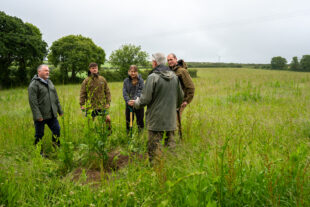https://defrafarming.blog.gov.uk/create-and-maintain-beetle-banks/
Create and maintain beetle banks
The guidance on this page is for SFI pilot participants only. Please visit GOV.UK for the official Sustainable Farming Incentive scheme guidance.
Find out how land managers can reduce crop pests and increase wildlife by making habitat for insects and spiders.
If you’re completing this action as part of the Sustainable Farming Incentive pilot, how you do it is up to you.
The advice on this page can help you get better environmental and business benefits, but you do not have to follow it to get paid.
Beetle banks
A beetle bank is a permanent, raised, uncut grassy strip across your field.
It provides habitat during winter for invertebrates like bees, beetles and spiders. Through the spring and summer they will spread out onto the surrounding land to feed on aphids and other crop pests.
Reducing crop pests can:
- improve the health of crops
- increase productivity
- reduce the need for insecticides
A beetle bank provides habitat for mammals and farmland birds. They can use it as a corridor to help them move around.
Using a beetle bank across a sloping field can also help to:
- stop pollution from fertiliser or pesticide reaching sensitive habitats
- prevent eroded soil from getting into watercourses or onto roads
- slow or divert the flow of flood water
How to make a beetle bank
Choosing a location
Beetle banks are most effective in fields over 20 hectares.
Make the bank across the middle of the field so invertebrates can spread out from the bank across the whole field during the summer.
In larger fields of 30 to 50 hectares, build 3 to 4 banks. You should space them evenly across the field.
It’s easiest to make the bank in the same direction as you cultivate.
If you’ll also use your beetle bank to control runoff and soil erosion, make it across the contour of the slope. Make sure the bank does not divert water which may cause problems somewhere else.
Do not create beetle banks on historic features.
Making the bank
Make the bank during your normal cultivations in spring or autumn.
Plough in opposite directions to make a raised bank at least 40cm above the normal level of the field, and between 3 and 5 metres wide. You might need to make multiple passes.
Make a firm, fine seedbed using shallow cultivation and lightweight machinery. Do not overwork the bank as this might flatten it.
Leave a gap at both ends of the bank where it meets the field boundary or margin so that you can easily get machinery in and out.
Banks you make in autumn can be left over winter so that weather breaks up the soil and create a seedbed. You can sow them the following spring.
You might need to spray with herbicide before sowing if weeds are present.
What to sow
Sow a seed mix with 3 or 4 tussocky grass species plus 2 or 3 finer grasses and flowers.
Sow tussocky grass species like:
- cock’s foot
- timothy
- meadow fescue
- tall fescue
To cover bare ground under tall grasses, use fine-leaved creeping grasses like:
- sheep’s fescue
- common bent
- red fescue
Flowers provide food for pollinators and attract other predatory insects like hoverflies which feed on crop pests. Choose tall species that can compete with thick grasses. Birds and harvest mice will use the stems for nesting and perching. Include species like:
- yarrow
- oxeye daisy
- wild carrot
- teasel
- common knapweed
- red campion
Choose species suitable for your soil type and sow at the rate recommended by your seed supplier. In most cases a rate of around 20kg per hectare should be suitable.
How to sow
Broadcast (scatter) seed in a way that will not damage the bank. You may be able to adapt existing equipment. You can:
- use a fertiliser spreader driven alongside the bank, to broadcast seed on each side
- use a slug pellet applicator towed along the bank by a quad
- broadcast by hand
Use a lightweight quad-drawn roller or hand roll after sowing to:
- improve seed-to-soil contact
- keep in moisture
- reduce the risk of slug damage
When to sow
You can sow your seeds at any time of the year, if the conditions are right for germination.
If you plan to sow in autumn, sow as early as possible into a warm, moist seedbed before poor weather sets in. If frost or prolonged wet weather is expected, leave sowing until the following spring.
Maintaining a beetle bank
A beetle bank takes about 2 to 3 years to establish.
Check the bank regularly to make sure weeds don’t take over.
Cut several times in the first summer to help grasses grow thickly. It’ll be hard for weeds to grow once grasses establish. For best results:
- use lightweight cutting machinery that will not flatten your bank
- remove cuttings or use machinery that cuts as finely as possible so that your sown species do not get smothered
Birds, nests and eggs are protected by law. You must check the bank before cutting. If you see signs of nesting birds, delay cutting until birds fledge.
After the first year, do not cut the whole bank in one go. This will help protect populations of insects and other wildlife.
You can control weeds and scrub by:
- spot spraying with herbicide
- localised cutting of problem areas
- digging
- pulling by hand
To prevent weeds do not apply fertiliser, manure or lime to the bank.
Insecticide and herbicide used on nearby crops can kill insects and plants. Protect the bank on each side with a buffer zone, like a strip of harvested or unharvested low-input cereal, a flower-rich margin or a pollen and nectar plot.
Do not let people walk or drive over or alongside the bank. This can:
- erode ground or leave it bare
- increase weeds
- make the bank less effective
- damage wildlife
What a good beetle bank looks like
You’ll see:
- thick tussocky grasses, including dead stems from previous seasons
- few weeds and little scrub
- invertebrates like ladybirds, ground beetles and spiders
- the bank acting as a barrier to runoff on sloping land
Very successful beetle banks will also have:
- farmland birds nesting and feeding
- small mammals like hares and harvest mice using the bank as shelter
- bumblebees and other pollinators



